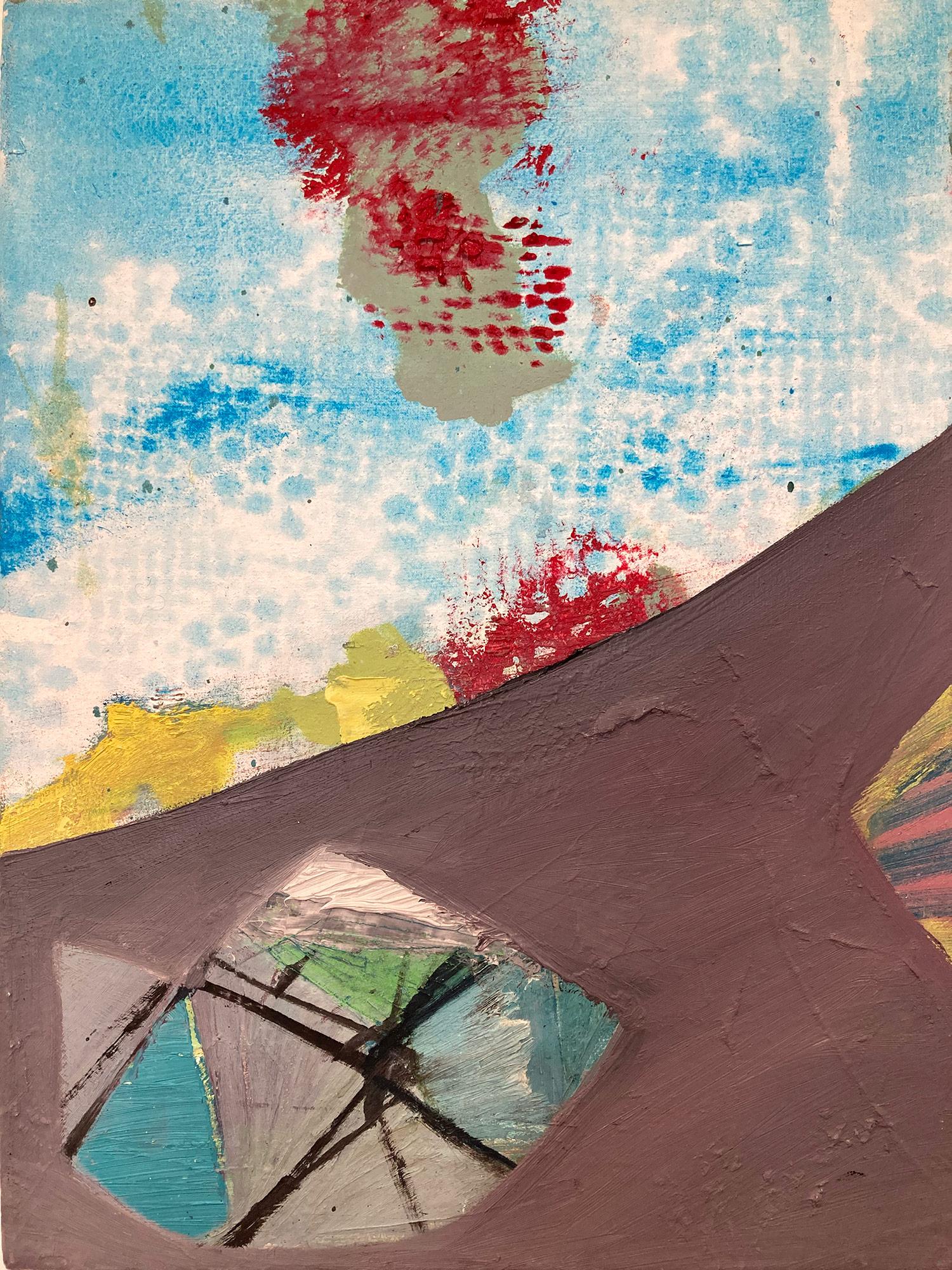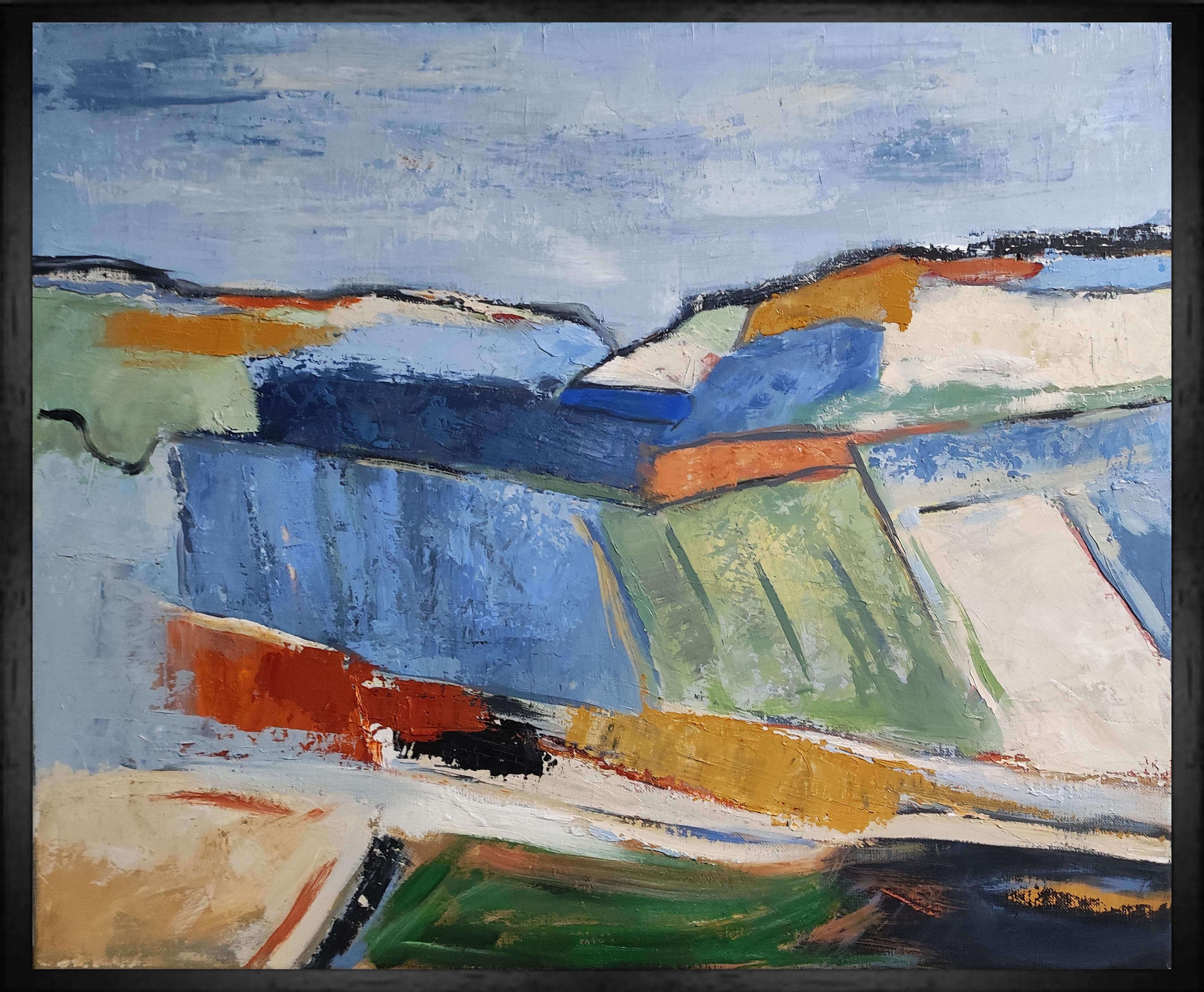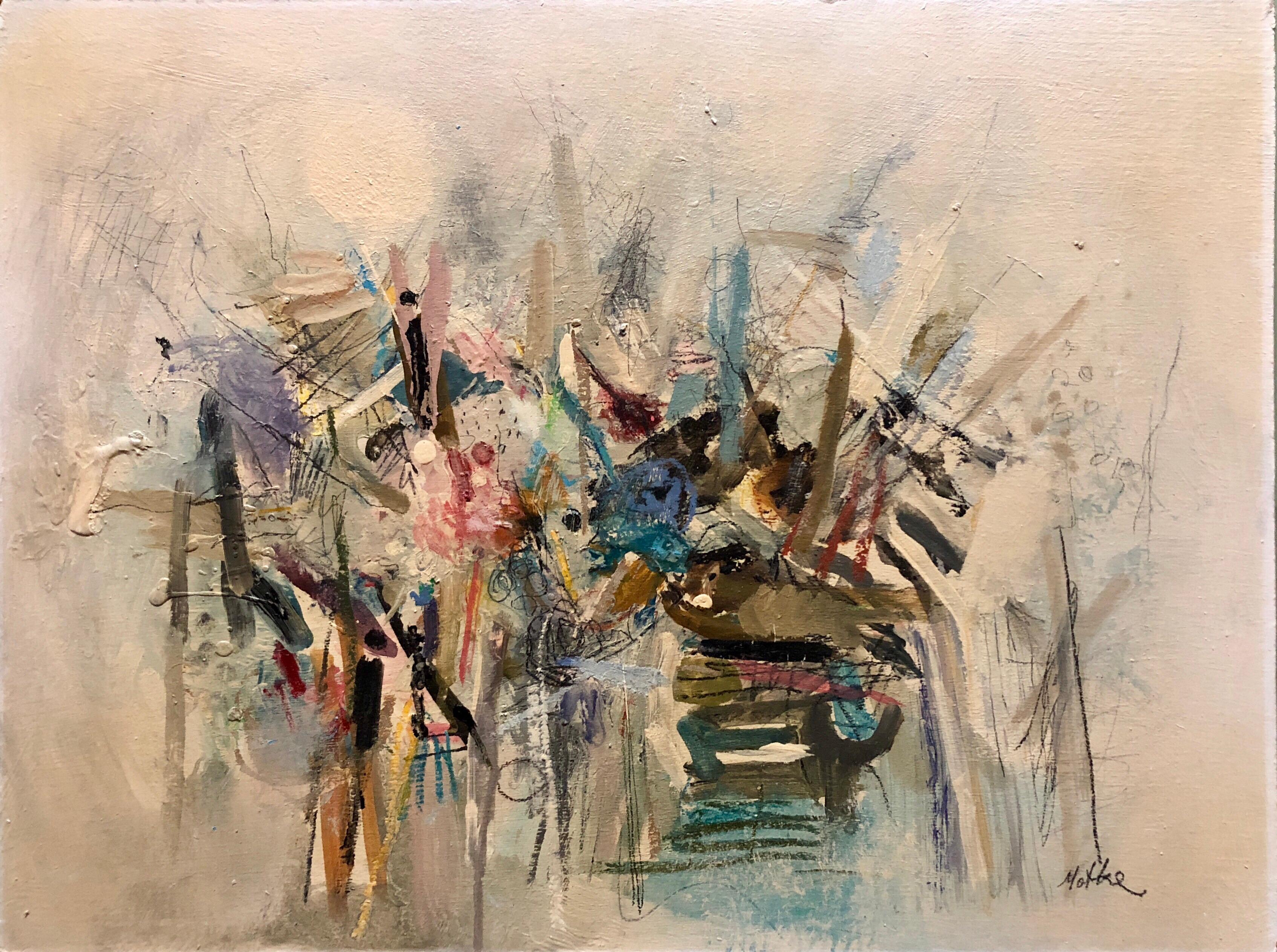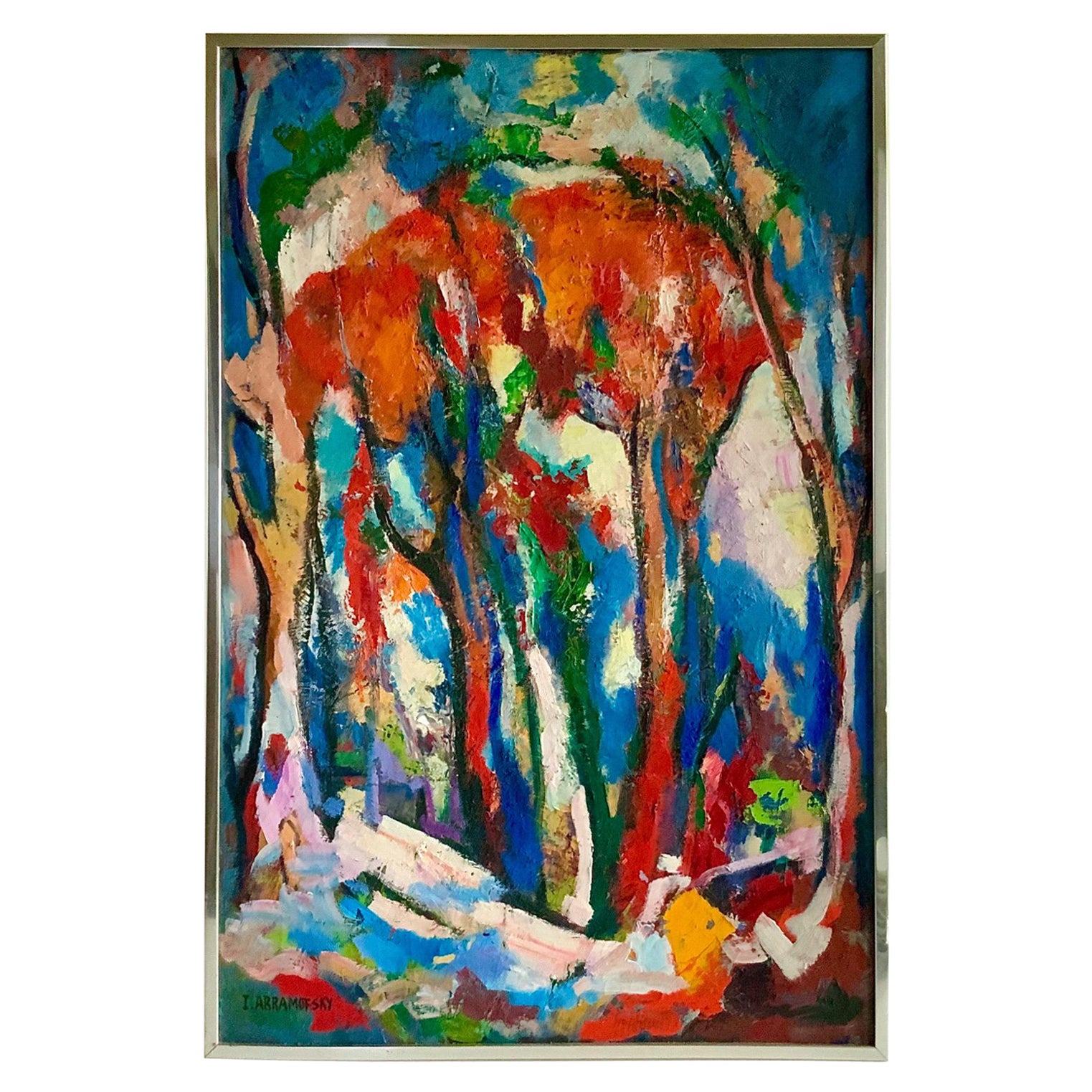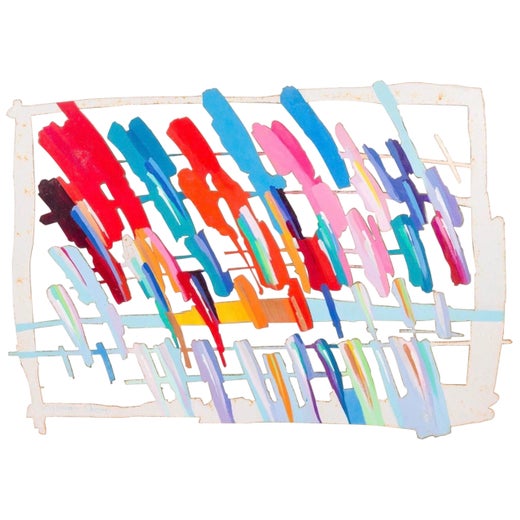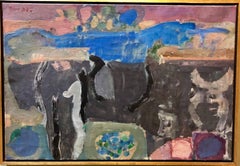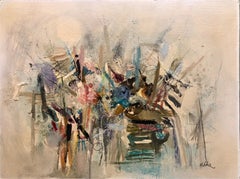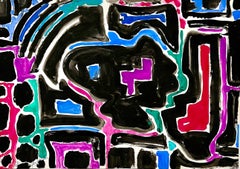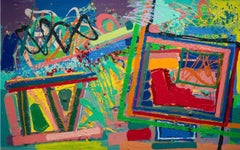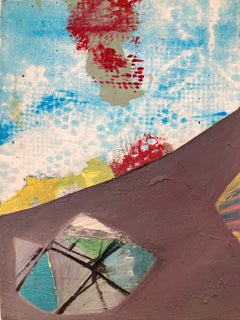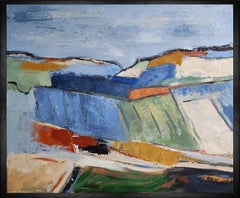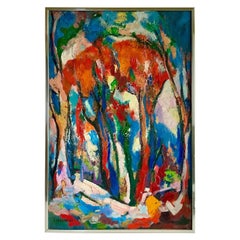Items Similar to Large Original Abstract Colorful Oil Painting Israeli Kibbutz Landscape Shemi
Want more images or videos?
Request additional images or videos from the seller
1 of 15
Calman ShemiLarge Original Abstract Colorful Oil Painting Israeli Kibbutz Landscape Shemi
$5,000
£3,790.69
€4,369.66
CA$7,041.70
A$7,808.72
CHF 4,102.90
MX$95,409.31
NOK 51,332.93
SEK 48,184.72
DKK 32,620.37
About the Item
Life in Nature
Canvas measures 31.5 X 39.5
(I believe this is oil it might also be acrylic.)
Hand signed recto and signed and titled verso.
Calman Shemi, sculptor and painter, was born in Argentina in 1939. A graduate of the School of Sculpture and Ceramics in Mendoza, he studied under the Italian-Argentinean sculptor Libero Badii whom he credits with putting him on the right path. “He taught me principals, not only related to sculpture, but human and philosophic principals. Shemi also carefully studied the work of such masters as Picasso, Caravaggio, Frank Stella and Matisse. “From each one of these great artists I learned something from observing them,” he says.
In 1961, at the age of 20, Shemi immigrated to Israel and joined Kibbutz Carmia of which he was a member for twenty years. There he worked in agriculture and also as a sculptor working with wood and clay. Several of his large-scale fiberglass and polyester projects are situated in public buildings. He was a student of German-Israeli sculptor Rudi Lehmann, a pioneer of the artistic movement known as “Canaanism.”
Canaanite art was an effort to create a direct relationship with the land, bypassing historic Jewish connotations—hence the land’s primordial name is used. Canaanite works, with an emphasis on the inter-action of simple shapes, bear a deliberate resemblance to the sculpture and ritual art of early civilizations of the Middle East prior to Judaism, always with an eye to the fusion of man and the land itself.
Though sculpture dominated his early years as an artist, in the mid ’70s Shemi developed the idea of the “soft painting” medium. Beginning with a color drawing done to scale, Shemi layers onto the drawing irregularly shaped pieces of variously textured and colored fabrics. Using a threadless 9,000-needle sewing machine, the fabrics are meshed to one another and to the background, resulting in vibrant carpet tapestry compositions infused with exuberant color and explosive movement. These are neither aubusson nor pile but more of a felt wall hanging style.
Over the years, Shemi has continued to challenge himself with new artistic mediums, developing two more techniques of painting: “Lacquer paintings” and “window paintings.”
He creates his Lacquer Paintings by applying vibrant colors to wood or metal panel that has been gilded with gold or silver leaf, and sometimes both. After the paint has thoroughly dried, many layers of lacquer are applied to the surface giving it a glowing effect. Between each layer of lacquer the piece is hand-polished to give the surface its very shiny look.
Shemi’s “lacquer” and “window” paintings are reminiscent of ancient techniques used centuries ago in Japan and China. Similar in the bright colorful mediterranean beaute of David Dudu Gerstein. Shemi concludes, “All of the art that I create is full of optimism and beauty. That’s all. Simple, very simple.” During the past eighteen years Shemi has held more than seventy one-man shows in the U.S., Japan, Germany, Spain, Belgium and Israel. His works can be seen in many public and private collections around the world.
Several of Shemi's large-scale fiberglass and polyester projects are situated in various public buildings throughout the world.
During the last years, Shemi has worked intensively with wall sculpture laser-cut steel, his new field of expression. He was in the group exhibition Reunion: Rudi Lehmann and Disciples at the
Haifa Museum of Art, 1989
Artists: Rudolph Rudi Lehmann, Hedwig Grossman Lehmann, Doron Bar Adon, Raya Bar Adon, Shoshana Heimann, Dan Zaretsky, Yigal Miron, Pinchas Eshet, Menashe Kadishman, Calman Shemi.
Over the last fifteen years, he has held more than seventy one-man-shows in the USA, Japan, Germany, Spain, Belgium and Israel.
Calman Shemi has achieved an art expression that has received international acclaim and acceptance. Very Appropriate for Memphis Milano Style interiors. Bright 1980s Artwork.
- Creator:Calman Shemi (1939, Argentinian)
- Dimensions:Height: 34.5 in (87.63 cm)Width: 43.5 in (110.49 cm)Depth: 2 in (5.08 cm)
- Medium:
- Movement & Style:
- Period:
- Condition:good, minor wear to frame.
- Gallery Location:Surfside, FL
- Reference Number:1stDibs: LU38215499772
Calman Shemi
Calman Shemi was born in Argentina in 1939. He studied sculpture and ceramics at the School of Mendoza in Argentina. In 1961, Shemi emigrated to Israel, and in 1963 he began studying sculpture with Rudi Lehman. He created his first "soft" paintings in 1977. Since 1978, he has worked primarily in serigraphy and acrylic paintings. In 1999, Shemi developed the "windows" and the "lacquer" painting techniques. The "window" or "shadow box" painting is a unique form of artistic expression. First Shemi creates a painting in a wooden box. After completion of the painting, he affixes a customized wooden frame to the box. This unusual technique results in the illusion of looking through a window to the landscape or into a room. The frame is then covered with silver or gold leaf and finally lacquered. The final result is a piece of art that emphasizes the contrast between the outside level and the painting within a deeper level.
Lacquer paintings are also one of Shemi's original creations. These works usually begin as an exciting abstract design or still-life painted on wood or on a metal panel that has been covered in layers of gold and/or silver leaf. After the paint has dried, the painting is gilded with many layers of lacquer. Between each layer of lacquer the surface is hand polished to give it a metallic finish, resulting in a luminous effect.
Remarkably, artist Shemi has had 71 one-man shows all around the world, including Israel, France, Singapore, Nigeria, Australia, Japan, Canada, Spain Germany, the United States and elsewhere. His works are displayed in the Spertus Museum of Judaica, the Fashion Institute of Chicago, Citibank in New York, the Hebrew University in Jerusalem, just to name a few.
About the Seller
4.9
Platinum Seller
Premium sellers with a 4.7+ rating and 24-hour response times
Established in 1995
1stDibs seller since 2014
1,801 sales on 1stDibs
Typical response time: <1 hour
- ShippingRetrieving quote...Shipping from: Surfside, FL
- Return Policy
Authenticity Guarantee
In the unlikely event there’s an issue with an item’s authenticity, contact us within 1 year for a full refund. DetailsMoney-Back Guarantee
If your item is not as described, is damaged in transit, or does not arrive, contact us within 7 days for a full refund. Details24-Hour Cancellation
You have a 24-hour grace period in which to reconsider your purchase, with no questions asked.Vetted Professional Sellers
Our world-class sellers must adhere to strict standards for service and quality, maintaining the integrity of our listings.Price-Match Guarantee
If you find that a seller listed the same item for a lower price elsewhere, we’ll match it.Trusted Global Delivery
Our best-in-class carrier network provides specialized shipping options worldwide, including custom delivery.More From This Seller
View AllLyrical Abstract Israeli Expressionist Oil Painting
By Hanna Ben Dov
Located in Surfside, FL
Hanna Ben Dov is an Israeli abstract painter who was born in Jerusalem in 1919 and died in Paris in 2008.
Ben Dov's father, Yacov Ben-Dov, was a famous Israeli photographer who founded the photography department in the Bezalel Academy of Art and Design in 1910. Hannah herself attended Bezalel during the 1940s, and later continued to Camberwell College of Arts in London. After the completion of her formal education she moved to Paris, where she exhibited for the first time in 1948 and has been living and working there since, as a part of the local abstract artists school. She took part in the first French Biennale of 1951, that was held in Menton.
Collections
Her paintings can be found in several collections, including the French State Collection, the Tel Aviv Museum of Art collection, the Bezalel National Museum collection in Jerusalem and the Rockefeller Museum collection in New York.
Ben Dov resided for her last two years at the Maison Des Artistes Home in Nogent-Sur-Marne, France, just outside Paris.
Exhibitions
Gallery97 Tel Aviv Paintings...
Category
20th Century Modern Landscape Paintings
Materials
Canvas, Oil
Israeli Modernist Abstract Expressionist Oil Painting
By Motke Blum
Located in Surfside, FL
size is with frame.
Motke Blum was born in Racacun, Romania in 1925. Early in his childhood, the Blum family moved to Bukarest where they settled in a house situated near a circus. ...
Category
Mid-20th Century Modern Abstract Paintings
Materials
Mixed Media
Abstract Israeli Landscape Jay Milder Rhino Horn Painting Jaffa, Israel Pop Art
By Jay Milder
Located in Surfside, FL
This came from the collection of the Horace Richter Gallery
These were done in the 1990's
Hand signed and dated by the artist. Old Jaffa
Jay Milder (born 1934) is an American artist and a figurative expressionist painter of the second generation New York School. Old Testament themes such as Jacob's Ladder and Noah’s Ark, and the Jewish mystical beliefs of the Kabbalah, are recurring themes in Milder’s paintings which are presented as archetypal images that recur in the basic karma, make-up and need of human nature. Internationally exhibited, Milder is included in the collections of many national and international museums.
He has been the subject of two, recent retrospectives in Brazil in 2007 at the National Museum Brasilia and, in 2006, at the Museum of Modern Art, in Rio de Janeiro. He is renowned in Sao Paulo, one of the major international centers for street and public art, as a seminal influence on graffiti artists. Jay Milder was born in Omaha, Nebraska, in 1934. His grandparents, who came from the Ukraine, were descendants of the Hasidic mystic, Rabbi Nachman. As he listened to family stories his interest in spiritualism and mysticism increased, and became an important influence on his philosophy of life and art. Later, when he arrived in New York, he was drawn to the Theosophical Society and the teaching of Helena Blavatsky.
In 1954 Milder visited Europe where he studied painting with André L’Hote, and sculpture with Ossip Zadkine. He spent much time studying at the Louvre Museum, and at the studio of Stanley Hayter. During his Paris years the paintings of the Jewish painter Chaim Soutine, primarily influenced him. Milder returned to the United States in 1956, and he began studying painting at the Chicago Art Institute. He exhibited with the Momentum Group, an alliance of artists who were particularly dedicated to the progression of figurative art and its global origins.
In 1957, Milder spent the summer in Mexico for a summer where he exhibited in Puebla. That year he received the Mexican Government’s Honor Award for artists.
In the summer of 1958, Milder studied with Hans Hofmann in Provincetown, Massachusetts. He exhibited his work at the Sun Gallery, with his contemporaries, including Mary Frank, Red Grooms, Bob Thompson...
Category
20th Century Abstract Expressionist Abstract Paintings
Materials
Paper, Gouache
Large Mod Abstract Expressionist Modernist Edward Avedisian Color Field Painting
By Edward Avedisian
Located in Surfside, FL
Edward Avedisian (American, 1936-2007)
Abstract Large Painting
Acrylic on panel heavily textured with a 3D effect.
Dimensions: 48"h x 75"w
Circa late 1970s, early 1980s
Provenance: ...
Category
1970s Abstract Expressionist Abstract Paintings
Materials
Acrylic, Wood Panel
Joan Kahn Rome Vibrant Bold Color Abstract Expressionist Modernist Oil Painting
Located in Surfside, FL
Oil paint on heavy tar paper.
Hand signed and dated verso.
Joan Kahn (USA 1953-) grew up in New York City; Princeton, New Jersey; and Vermont; in an environment that patronized the arts. At home her father, a professor, and mother, a state economist and homemaker, collected nineteenth and twentieth century drawings and prints, Middle eastern rugs, and ceramics, pewter, and old tools. Her grandfather, Max Westfield, was an academically trained portrait painter and her great uncle was a well-known gallery owner and art dealer in pre-World War II Germany. One of the influential experiences of Joan’s youth was visiting her grandfather in his studio in Tennessee where the family had first immigrated.
Growing up near New York, and spending a year in Paris during high school, provided formative visits to museums and galleries. Joan was academically talented in grade and high school, but after her father’s death during her first years at university she found herself concentrating on studio and history of art. It was a subject above others absorbed and concentrated her focus.
Influential in Joan’s development and later work are the historic movements of the Bauhaus and Modernist design and architecture, geometric art and design of diverse cultures, Color Field Painting. Many artists have had a impact on her work, such as Paul Klee, Piet Mondrian, Sonia Delaunay, Mark Rothko, Ad Reinhardt, Antoni Tapies, David Smith, John McLaughlin, Tony Smith, Louise Nevelson, Robert Mangold, Ellsworth Kelly, Agnes Martin, Valerie Jaudon, Jasper Johns, James Turrell, Robert Irwin, Vija Celmins, Caio Fonseca, Peter Halley, Ed Moses, Juan Usle, and Nancy Haynes...
Category
1980s Abstract Expressionist Abstract Paintings
Materials
Oil
Large Mod Abstract Expressionist Modernist Edward Avedisian Color Field Painting
By Edward Avedisian
Located in Surfside, FL
Edward Avedisian (American, 1936-2007)
Abstract Large Painting
Acrylic on panel heavily textured with a 3D effect.
Dimensions: 48"h x 75"w
Circa late 1970s, early 1980s
Provenance: ...
Category
1970s Abstract Expressionist Abstract Paintings
Materials
Acrylic, Wood Panel
You May Also Like
"Landscape Composition" Greek Abstract Expressionist Oil Painting on Canvas
By Eozen Agopian
Located in New York, NY
This piece is a bold display of Eozen Agopian's structurally strong pieces, with an intense color of Blue and green and pops of blue, red and white, mimi...
Category
Early 2000s Abstract Expressionist Abstract Paintings
Materials
Canvas, Oil, Mixed Media
Geometric landscape, Abstact, Colored, Oil on canvas, textured, Expressionism
By SOPHIE DUMONT
Located in LANGRUNE-SUR-MER, FR
Abstract colorful countryside landscape. The artist appropriates this Normandy countryside where the fields are increasingly disappearing in favor of urbanization. She captures every...
Category
21st Century and Contemporary Abstract Expressionist Landscape Paintings
Materials
Oil
Textured Abstract Landscape – Oil on Canvas, French Artist, "Cadence Champêtre"
By SOPHIE DUMONT
Located in LANGRUNE-SUR-MER, FR
Oil on canvas
Size Framed : 57 x 57 x 3,5cm (22,44 x 22,44 x 1,38 in)
unframed: 50 x 50 x 2 cm (19,69 x 19,69 x 0,79 in)
Sophie Dumont is a contemporary painter who explores the i...
Category
21st Century and Contemporary Abstract Geometric Abstract Paintings
Materials
Oil
Mid-Century Isreal Abramofsky Abstract Oil on Canvas
Located in Haddonfield, NJ
Abstract Oil Painting featuring heavily applied paint with a nice, raised texture, by Isreal Abramofsky, Russian 1888-1975, Toledo, Ohio Artist.
Abramofsky was a Russian born artist...
Category
20th Century American Mid-Century Modern Paintings
Materials
Wood, Paint
Fran Shalom "Untitled 6" -- Colorful Abstract Oil Painting on Canvas
By Fran Shalom
Located in New York, NY
Fran Shalom
Untitled 6, 2020
oil on canvas
16 x 16 in.
(sha038ap)
This abstract oil painting on canvas is bold, bright, and colorful, in highly saturated shades of red and orange se...
Category
2010s Abstract Abstract Paintings
Materials
Canvas, Oil
Chromatic Landscape -Terres fauves, Abstract, oil on canvas, Expressionist
By SOPHIE DUMONT
Located in LANGRUNE-SUR-MER, FR
Sophie Dumont is a contemporary painter who explores the intersection between abstraction and landscape, blending energy and serenity. Her intuitive and subtle approach is inspired b...
Category
21st Century and Contemporary Abstract Expressionist Abstract Paintings
Materials
Oil
More Ways To Browse
Gilded Age Paintings
Italian Ceramics Abstract
Israeli Artist Abstract Sculpture
Japan Abstract Art Midcentury
Israel Tapestry
Mid Century Chinese Landscape Painting
Jewish Metal Art
Large Oil Mediterranean Paintings
Clay Sculpture Abstract Mid Century
Japanese Wood Bear
Metal Wall Sculptures 1980s
Fiberglass 70s
Jewish Carpet
Mid Century Mesh Sculpture
Fiberglass Wall Panel
Hand Painted Aubusson Canvas
Calman Shemi Original Paintings
Jose Ramos

